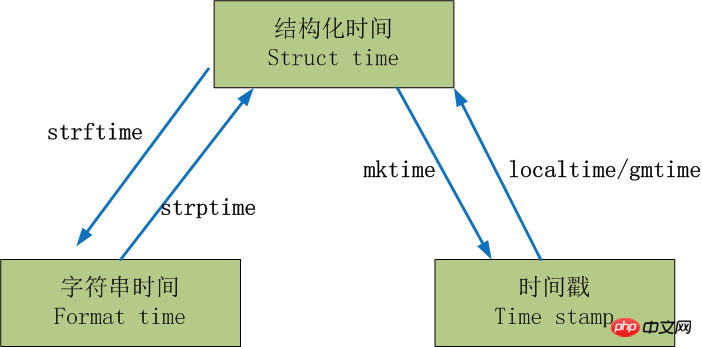
模块本质就是一个.py文件,在安装目录下的lib文件夹下可以看到
模块分为三个部分:内置模块(存在于解释器中),第三方模块(lib文件夹下),自定义模块(自己定义的)
1.time模块
import time#返回当前时间的时间戳print(time.time())#1498027773.1063557#以时间戳为参数,返回结构化的时间元组,参数默认为当前时间print(time.localtime(1912412470))#time.struct_time(tm_year=2030, tm_mon=8, tm_mday=8, tm_hour=17, tm_min=41, tm_sec=10, tm_wday=3, tm_yday=220, tm_isdst=0)#以时间戳为参数,返回结构化的格林尼治时间,默认参数为当前时间print(time.gmtime()) #time.struct_time(tm_year=2017, tm_mon=6, tm_mday=21, tm_hour=6, tm_min=49, tm_sec=2, tm_wday=2, tm_yday=172, tm_isdst=0)#结构化时间转化成字符串时间print(time.strftime('%Y:%m:%d-%X',time.localtime())) #2017:06:21-14:48:50#字符串时间转化为格式化时间print(time.strptime('1993-10-15','%Y-%m-%d')) #time.struct_time(tm_year=1993, tm_mon=10, tm_mday=15, tm_hour=0, tm_min=0, tm_sec=0, tm_wday=4, tm_yday=288, tm_isdst=-1)#结构化时间转换成时间戳print(time.mktime(time.localtime()))#1498027859.0print(time.asctime()) #Wed Jun 21 14:53:11 2017print(time.ctime()) #Wed Jun 21 14:53:11 2017#线程推迟指定时间运行,参数为指定的秒数time.sleep(5)几种时间形式的转换:

2.random模块
import randomprint(random.random())#随机返回一个(0,1)之间的浮点数 0.40165771797504246print(random.randint(1,3)) #随机返回一个指定范围[1,3]的int类型 3print(random.randrange(1,3)) #随机返回一个指定范围[1,3)的int类型 1print(random.choice([12,21,23,34,'a','b']))#随机返回一个指定列表中的元素 12print(random.sample([12,21,23,34,'a','b'],3))#随机返回指定个数的指定列表中的元素 ['a', 21, 'b']print(random.uniform(1,3))#随机返回一个(1,3)之间的浮点数 2.2162483038520144l=[1,2,3,4,5,6] random.shuffle(l) #把指定列表的顺序打乱print(l) #[1, 3, 6, 2, 4, 5]
练习
#练习,随机生成一个5位的验证码,包括数字,大小写字母import random res=''for i in range(5): num=random.randint(0,9) alpA=chr(random.randint(65,90)) alpa=chr(random.randint(97,122)) s=random.choice([str(num),alpA,alpa]) res=res+sprint(res)
3.os模块
1 import os 2 3 #获取当前工作目录 4 print(os.getcwd()) #C:\untitled\0621day12 5 6 #改变当前工作目录,相当于shell中的cd 7 os.chdir(file_path) 8 9 #生成多层递归目录10 os.makedirs('dirname1/dirname2')11 12 #递归删除空目录13 os.removedirs(path)14 15 #生成单级目录16 os.mkdir('dirname')17 18 #删除单级空目录,目录不为空则不能删除19 os.rmdir(path)20 21 #列出指定目录下的所有文件和子目录,包括隐藏文件,以列表方式打印22 print(os.listdir(r'C:\untitled\0612Python第五天')) #['0612作业.py', 'a.txt', '作业题目', '字符编码.py', '文件操作.py']23 24 #删除一个文件25 os.remove()26 27 #重命名文件/目录28 os.rename('oldname','newname')29 30 #获取文件/目录信息31 os.stat(path)32 print(os.stat(r'C:\untitled\0612Python第五天')) #os.stat_result(st_mode=16895, st_ino=2814749767244350, st_dev=3504670893, st_nlink=1, st_uid=0, st_gid=0, st_size=4096, st_atime=1497356489, st_mtime=1497356489, st_ctime=1497227714)33 34 #返回文件目录,其实就是os.path.split(path)的第一个元素35 os.path.dirname(path)36 37 #返回文件的文件名,其实就是os.path.split(path)的第二个元素38 os.path.basename(path)#如果path以/或\结尾,则会返回空值39 40 #如果文件存在,则返回True,否则返回False41 os.path.exists(path)42 43 #如果path是绝对路径,则返回True44 os.path.isabs(path)45 46 #将多个路径组合后返回,第一个绝对路径之前的参数将会被忽略47 os.path.join(path,paths)48 49 #返回path所指向的文件或目录的最后访问时间50 os.path.getatimme(path)51 52 #返回path所指向的文件或目录的最后修改时间53 os.path.getmtime(path)54 55 #返回path的大小56 os.path.getsize(path)4.hashlib
hashlib模块提供了常见的摘要算法,如MD5,SHA1等,在Python3中,hash直接代替了MD5和SHA
摘要算法是通过一个函数,把任意长度的数据转成一个长度固定的数据串。
1.摘要算法是不可逆的,不能由数据串反推得到元数据
2.两个数据,即使只有1bit的区别,得到的摘要也是没有任何关系的
3.无论元数据有多大,得到的摘要都是固定长度的
4.当元数据很大时,需要一行一行去读,然后一行一行的校验,最后一个.hexdigest()能把之前所有的校验结果得到一个摘要
MD5速度很快,也很常用,生成结果是固定的128bit的通常由一个32位的16进制字符串表示。
import hashlib
md5=hashlib.md5()
md5.update('aasg'.encode('utf-8'))#434c591c9c5a04e44ec8dbafe81058e7md5.update('adasdg'.encode('utf-8'))#d20a55b2194493fdeb66e2cd358dab15md5.update('aasgadasdg'.encode('utf8'))#d20a55b2194493fdeb66e2cd358dab15print(md5.hexdigest())未完待续。。。。
The above is the detailed content of An introduction to some commonly used modules in Python. For more information, please follow other related articles on the PHP Chinese website!




